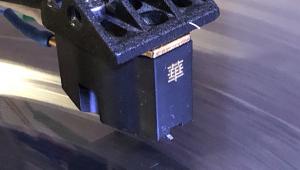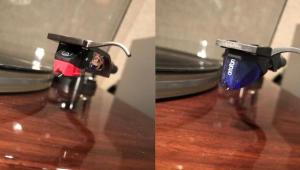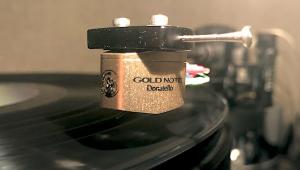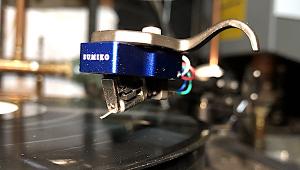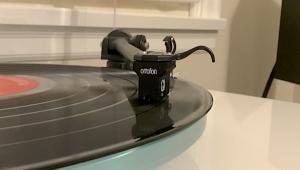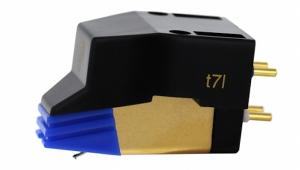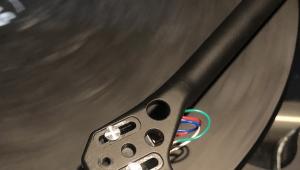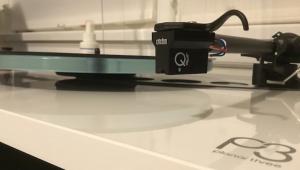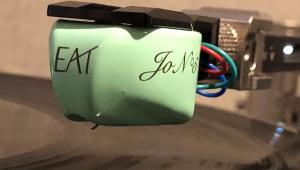Lyra Parnassus D.C.t phono cartridge
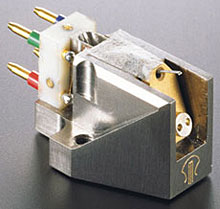 Can you really get your money's worth from cartridges that cost more than non-Stereophile readers spend on an entire stereo system? From ones that cost twice as much? They're out there. Is it worth having to handle something so pricey you have an anxiety attack every time you want to play a record?
Can you really get your money's worth from cartridges that cost more than non-Stereophile readers spend on an entire stereo system? From ones that cost twice as much? They're out there. Is it worth having to handle something so pricey you have an anxiety attack every time you want to play a record?
Unfortunately, yes—assuming the rest of your system, especially your analog front-end, is capable of resolving what today's best cartridges can deliver. Do they do things the good $1000 and $2000 cartridges don't? In my experience, yes. Nonetheless, once past the $2000 price point, the curve of diminishing returns begins to flatten rather dramatically, and the differences become more subtle. They're still significant, but...subtle.
When you're spending $3500 or four grand on a phono cartridge, you have a right to expect a high degree of sonic accuracy. These days, if you find one expensive, high-performance cartridge that sounds radically different tonally from the rest, my experience is that it is either highly colored or defective.
If you're fortunate enough to hear a number of top performers under controlled conditions, you'll find that they all achieve a certain level of sonic performance, yet they all sound different in subtle but musically significant ways. In making your choice, you're going to have to examine those differences and blow them way out of proportion—which is what I had to do to review these two contenders, both of which make glorious-sounding music.
Cartridges are often compared to loudspeakers because both are transducers—they turn one form of energy into another. And while speakers and cartridges are the least accurate links in the audio chain, loudspeaker systems are far more complex and must interact with both the amplifier and the wildly variable room acoustic. Cartridges certainly have some tricky interfaces—record grooves, tonearms, phono-stage loads—but today's high-tech cartridge motors are far more accurate and predictable transducers than those used in the past.
All of the high-priced cartridges I've auditioned and reviewed over the past four or five years share certain characteristics that distinguish them from budget models. They all overcome the "edge" and grain structures lesser cartridges tend to impose on the music, but without softening or obscuring transient information and inner detail. (But if you're used to "edgy" performance, these sophisticated cartridges may sound "soft" at first.) In fact, as you'd expect and demand for your money, they resolve transients better and reveal more low-level detail, both spatially and musically, while avoiding the bright/hard or soft/warm tendencies of lesser designs. Overall distortion is much lower as well.
All premium cartridges, to differing degrees, have fewer frequency-response aberrations. They reproduce the frequency extremes with the same authority as they do the midband, and come closer to the ideal "flat" wideband response. But, like loudspeakers, all cartridges have some defining frequency-based character. Some of these characters are accidental; some, I suspect, are purposely "tuned in."
The expensive cartridges I've auditioned are built more carefully than massmarket models, both in terms of the quality and perfection of the parts used and in the way they're put together. This helps them achieve a better geometric relationship with the record groove. The result is superior separation, which creates wider, better-defined, and more accurate soundstages, more focused images, and better front-to-back image specificity.
When you spend $3000 or more on a phono cartridge, you should hear an immediate sense of ease, refinement, and liquidity, especially in the midband; a feeling of authority and control over the music; a complete freedom from "electronica" and artificiality. The better cartridges manage to untangle previously impenetrable webs of complex musical information without spotlighting or highlighting anything revealed. You sense that though a hundred events might be occurring simultaneously on the soundstage, you can hear each one individually. You can tune in and out of musical conversations much the way you can between people in a crowded room. And none of the images within the soundstage should appear to come anywhere near the confines of the drivers or cabinets.
Large-scale dynamic events like orchestral crescendos should strike your ears with a fast, violent impulse—uncompressed and completely controlled. And they should recede without a trace, leaving just the echoes ricocheting off the hall walls, clearly defined in a much different space. Low-level dynamic events—frequently occurring simultaneously with the large ones—should be portrayed with equal impulse clarity and detail, but in proper proportion.
Air, space, rich harmonic overtones, explosive dynamics, transparency, woody wood, metallic metal, fleshy flesh, a thousand colors, and a rich, seemingly limitless sonic bouquet—all, impossibly, painted by a stupid little diamond fleck motoring along a black vinyl highway. That's the goal. That's what's possible—performance I've yet to hear equaled by any CD player.
We like to think we get these things with $295 cartridges, and to some degree we do, but if you've heard either of these cartridges or any top performer, you've most likely heard and appreciated the difference made by superior materials, sophisticated design, precise construction, special ether, a cool wooden box, sleek styling, and snob appeal.
Parnassus
If Koetsu, for example, shrouds itself in mystery, Scan-Tech, creator of the Lyra cartridge line, is an all-nuts-and-bolts technocracy. Designed by the very accessible Jonathan Carr and built by Yoshinori Mishima in Japan, the Parnassus D.C.t holds no mysteries, but is an upscale version of the very popular Clavis D.C. (See review in Stereophile, Vol.19 No.4.)
According to Carr, the D.C.t's body is milled from a solid block of aircraft-grade titanium (hence the "t" suffix). Like the Clavis D.C.'s, the Parnassus' cantilever is fabricated from Ceralloy—an aluminum alloy reinforced with ceramic "whiskers"—which Carr told me is stronger than carbon fiber. Unlike the Clavis, the cantilever is further stiffened with a diamond plasma coating.
The diamond stylus is the same as the Clavis's, a 60µm-square Ogura PA profile—a line-contact-like shape—which Carr says is the smallest and lightest made. Ogura also puts the diamond in the laser-bored cantilever and builds the cantilever assembly for Scan-Tech from parts they supply to Ogura, including the five-nines iron "former" (bobbin) and six-nines copper-coil wire, which is wound in a single layer. According to Carr, only two companies in Japan supply diamonds and build cantilever assemblies: Ogura and Namiki.
Like the Clavis D.C., the Parnassus D.C.t uses a unique construction technique. Whereas most cartridges feature a self-contained motor assembly (cantilever, coils, magnet/pole-piece assembly, suspension wire, stopper pipe) affixed to a body, the Clavis D.C. and Parnassus D.C.t feature motor assemblies that are integral to their bodies. This requires ultraprecise machining of the titanium block in order for all parts to fit and maintain proper geometry. (For more on this, please read the Clavis D.C. review in Vol.19 No.4.)
Why did Carr design it this way? For added rigidity. Carr sees music as a series of impulses (Yikes! Digital!) rather than as a continuous stream. As energy travels up the cantilever and into the motor assembly, it needs a path to get out of the way or it will travel back down and interfere with the next impulse, already on its way up. By mechanically grounding the "stopper pipe"—ie, the back end of the cantilever assembly—into a tiny hole machined into the titanium body, Carr feels he's given the energy a way out so it can be transmitted to the arm, where some of it is dissipated as heat and the rest (on some arms) is grounded in the plinth. That's the theory.
At $3495, the D.C.t is almost double the price of the $1895 Clavis D.C. Why? According to Carr, the more rigid titanium body is far more expensive than the Clavis' aluminum one, and machining is far more difficult and time-consuming. In addition, the diamond coating on the cantilever, which is done in Germany, adds cost, as does the more complex internal assembly. Also, unlike most cartridges, the Clavis D.C. and Parnassus D.C.t do not use conventional magnet/pole-piece assemblies. Instead, they use a pair of very powerful ring magnets threaded directly onto the cantilever assembly.
Again, while this design aspect is key to the cartridge's performance, it—and many other aspects of cartridge design in general—are covered in great detail in the Clavis review in the April '96 Stereophile. Please read it if you are at all interested in this fascinating aspect of analog sound reproduction.
The Parnassus D.C.t puts out 350µV at 5cm/s using the CBS STR-100 test record, and 250µV using the JVC TRS-1007 standard record (Lyra's normal reference). (Perhaps I'll cover the controversy over phono-cartridge output measurements in a future "Analog Corner.")
Setup & Sound
I auditioned both the Koetsu Urushi and Parnassus cartridges extensively (such work!) in the Immedia RPM2, Graham 2.0, and Simon Yorke arms. For the sake of quick back-and-forths and to hear the effects of different arm wires, I did most of my final A/B listening using the Graham 2.0.
First of all, throw out all the clichés you may have heard about these two cartridge makers. The Koetsu is not "soft and rolled" on top, nor does it have a warmth-inducing midbass hump. Nor is the Parnassus D.C.t "bright and analytical" or "wimpy," as some have incorrectly characterized the original Parnassus.
Both of these cartridges did everything described in this review's introduction. You pay the big bucks for ease and grace—and freedom from "mechanicalness"—and you get them. I did, anyway. Both were dynamically and spatially explosive, creating an accurately shaped soundstage that had no connection to the loudspeakers. Both focused three-dimensional images everywhere on the stage, and both resolved incredible amounts of low-level and harmonically adjacent information.
For example, on The Beatles, at the end of "The Continuing Story of Bungalow Bill," everyone's singing "Hey, Bungalow Bill..." Can you easily hear that it's Ringo's nasal, three-dimensional voice singing in the background? These cartridges didn't just pass on low-level information, they served it up on a platter.
Not that these two fine performers sounded identical. They didn't. The tonal clichés were reduced to "tendencies." The Koetsu was slightly richer in the lower midrange, which made strings "sing" with a rich, vibrant, ever-spreading glow. The Parnassus D.C.t gave me more of the bow, a bit less of the body. On Sinatra's At the Sands—a fantastic Lowell Frank recording—the D.C.t gave me more of the live event (the nightclub ambience and PA sound), the Koetsu more of Frank's direct mike feed—a more intimate Frank, but with less of the context.
It is precisely because both cartridges were so revealing that different arm cables, loadings, and slight changes in setup had such profound effects, and could even make one cartridge almost mimic the other.
The title cut from a British RCA pressing of David Bowie's The Man Who Sold the World is a really fine Ken Scott Trident Studios four-track recording. (Forget the digitally remastered Rykodisc LP.) In the left channel are a guiro "scratcher," a wood block, and a processed electric guitar; in the right channel are an acoustic rhythm guitar and, way in the background but very cleanly recorded, the drums: long tom and snare runs punctuated by rich, splashy cymbal work. In the middle are Bowie—slightly flanged or processed some other way—the bass, and what sounds like a primitive analog synthesizer.
Using Cardas' new Neutral Reference tonearm cable (speaking of throwing away clichés, there's nothing soft and warm about this cable; it's superbly transparent and extended on top), the Parnassus D.C.t delivered the scratcher with a perfect balance of gourd and percussive etch as the striker rides along the instrument's undulating ridges. The woodblock "popped" cleanly and warmly. Bowie's voice rippled with the flange effect. In the right channel, the acoustic guitar strums had both string and body, and the cartridge delivered the complex timbre and tonality of the drums intact. The distant cymbals splashed and shimmered with incredible texture even as they decayed into blackness. Despite its obscure placement in the mix, I could easily listen to just the drum performance for the full song and hear a low-level but tonally rich, dynamically convincing portrayal of the instrument.
Switching to the Koetsu, the scratcher's percussive etch was ever so slightly diminished in speed, but the hollowness of the gourd was revealed in somewhat greater relief. The woodblock "popped" a bit less quickly, but with a bit more wood sound. Bowie's voice lost a touch of the flange effect, the acoustic guitar revealed a bit more body and a little less string, the toms were rounder, the snare a hair less distinct, the cymbals lost some shimmer and "splashiness," and the performance was slightly obscured dynamically by the rest of the mix.
Both of these cartridges had outstanding bass response: deep, tight, rich, and complex. The Koetsu's richness did not come at the expense of bass definition or control, nor did the Parnassus D.C.t's speed and detail rob the bottom octaves of weight. Overall, though, the D.C.t's bass was somewhat tighter and more explosive, the Koetsu's richer and somewhat slower.
I auditioned both cartridges with a variety of arm cables. Depending on the choice, I could tamp down and soften the Parnassus' top-end extension and make it resemble the Koetsu's slightly warmer overall tonality, but not its subtly lush lower midrange. Some cables obscured the cymbal splashes on the Bowie cut to where I was hardly aware of them. A capacitance issue? Perhaps. In any case, what I heard with any of these revealing cartridges was, to a great degree, related to associated equipment, setup, and loading.
Speaking of which, I tried both with the preamp set to 47k ohms but preferred 100 ohms. In most cases I still think a moving-coil cartridge needs to be loaded down to prevent ringing. Ultimately, you have to let your ears be the judge—but don't confuse distortion (underdamped ringing) with spatiality.
The subtle tonal difference between the cartridges had a predictable effect on soundstaging and imaging. The D.C.t provided an airier, taller stage, with greater rear-stage "spotlighting." The Koetsu's warmer, richer balance provided a somewhat "wetter" sensation of air, as if the event had been recorded on a more humid day. Soundstage height was somewhat lower, but there was a greater sensation of depth in the corners.
Some may argue with this assessment, saying, "What really counts is which is more accurate to the sound of the venue in which the recording was made." But that depends to a large degree on the tonal balance and imaging and soundstaging abilities of not just the cartridge, but the rest of the system as well. That one cartridge/speaker combination adds up to a balance that accurately portrays the venue of a particular recording does not necessarily mean that the cartridge is more "accurate"—except in that system.
While the Koetsu wasn't soft and overly warm and the Parnassus D.C.t wasn't bright and aggressive—these two cartridges are way too refined and carefully "voiced" to be so unsubtle about their overall sonic "tendencies"—those who value transparency, "speed," retrieval of inner detail, and stolid but exciting neutrality will prefer the Parnassus D.C.t's fast, energetic portrayal of transients, reverberant tails, and spatial cues. The Parnassus D.C.t was in many ways an "electrostatic"-like transducer. In fact, it is the most revealing, detailed, and transparent cartridge I've ever heard in my system. I heard new details in just about every record I played.
What's really impressive about these cartridges is that both have enough of the other's strong suits to make them enjoyable, regardless of your sonic preferences. The Koetsu was particularly engaging on the Heifetz and Ricci records, but the D.C.t was also credible, with just a slight shift of emphasis. The D.C.t was more convincing on live recordings, conveying more of the room sound and atmosphere—the D.C.t was the cartridge on the Sinatra record—but the Koetsu was "lively" enough to be exciting. It could rock, too, though not quite as dynamically.
Nonetheless, there are some cautions: the D.C.t coupled with a Krell/Wilson or Levinson/Martin-Logan system might take things too far in the wrong direction. The D.C.t's low output means it must be used with a low-noise/high-gain phono section to get the dynamic, high-resolution performance of which it is capable. Audiophiles and reviewers who complain about this cartridge's dynamics should look to their phono sections and/or tonearms. I auditioned these cartridges using a variety of phono sections and active and passive line sections. During the last few weeks of the reviewing process I used the Ayre K-1 solid-state preamplifier—my new reference, which I've purchased. Its combination of ultra-low noise, tonal neutrality, transparency, and high output proved ideal for both cartridges.
Conclusion
Both of these cartridges are hand-built by skilled artisans who push, pull, and bend these babies into submission before they reach your hands. Both come in cool boxes, are made from exotic materials, have great snob appeal, and will give you pride of ownership. Both have a special ether that can be seen only under particular, mysterious conditions I'm not allowed to divulge. And both will cause anxiety attacks during installation and with each play. But if you treat them right, they'll do likewise, and give you years of listening pleasure.
Both of these cartridges demand ultra-rigid-bearing tonearms and medium- to high-mass arms to perform at their peaks—and meticulous setup. Sloppy bearings and resonances will accentuate their essential and positive characters in negative ways: the Koetsu will sound sluggish and unfocused, the Parnassus D.C.t edgy and thin. If you hear those qualities with these cartridges, the fault lies elsewhere!
If you're disappointed that I'm not telling you why one cartridge is "better" than the other, sorry. These are two fantastic performers; I have my preference (the D.C.t), but it shouldn't necessarily be yours.
- Log in or register to post comments



